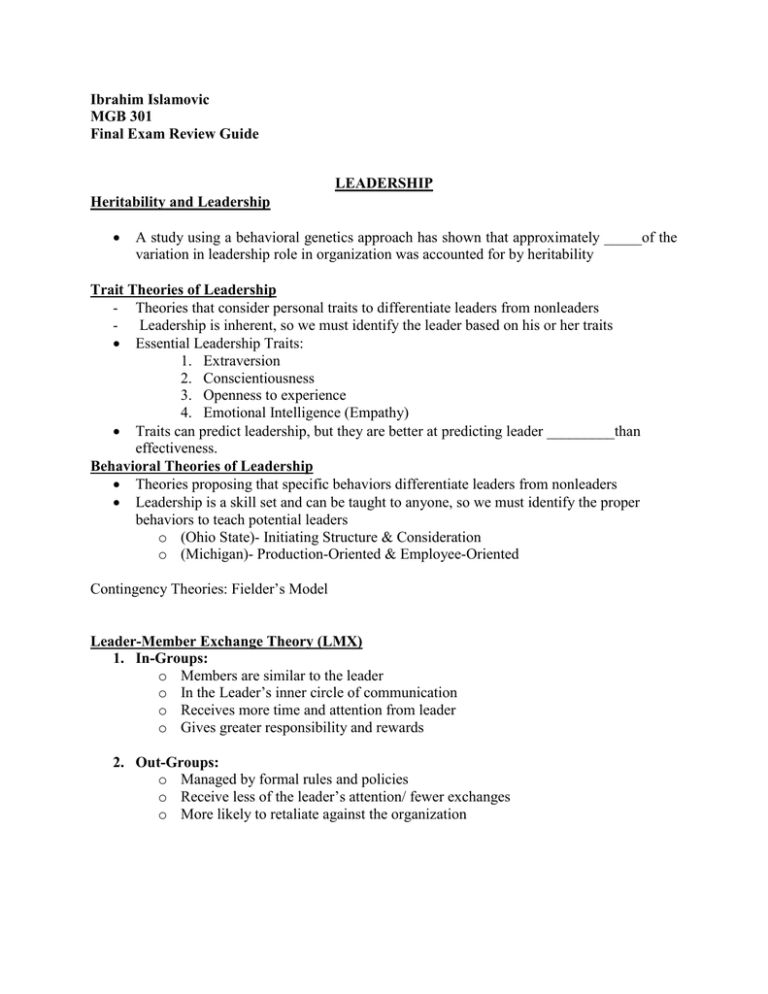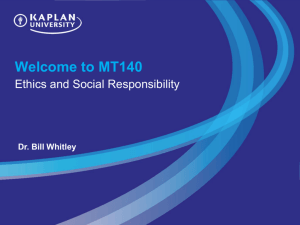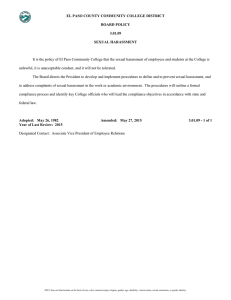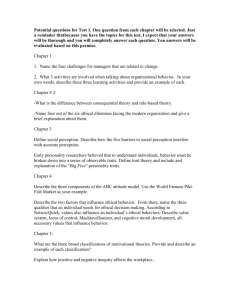MGB FINAL Study Guid..
advertisement

Ibrahim Islamovic MGB 301 Final Exam Review Guide LEADERSHIP Heritability and Leadership A study using a behavioral genetics approach has shown that approximately _____of the variation in leadership role in organization was accounted for by heritability Trait Theories of Leadership - Theories that consider personal traits to differentiate leaders from nonleaders - Leadership is inherent, so we must identify the leader based on his or her traits Essential Leadership Traits: 1. Extraversion 2. Conscientiousness 3. Openness to experience 4. Emotional Intelligence (Empathy) Traits can predict leadership, but they are better at predicting leader _________than effectiveness. Behavioral Theories of Leadership Theories proposing that specific behaviors differentiate leaders from nonleaders Leadership is a skill set and can be taught to anyone, so we must identify the proper behaviors to teach potential leaders o (Ohio State)- Initiating Structure & Consideration o (Michigan)- Production-Oriented & Employee-Oriented Contingency Theories: Fielder’s Model Leader-Member Exchange Theory (LMX) 1. In-Groups: o Members are similar to the leader o In the Leader’s inner circle of communication o Receives more time and attention from leader o Gives greater responsibility and rewards 2. Out-Groups: o Managed by formal rules and policies o Receive less of the leader’s attention/ fewer exchanges o More likely to retaliate against the organization Charismatic Leadership 1. Charismatic Leaders Influence Followers by: Articulating an appealing _____ Developing a _____ Statement Establishing a new set of values Conveying courage and conviction about the ______ - People are especially receptive when they sense a crisis, when they are under stress, or when they fear for their lives. Transformational Leaders - Transformational leaders _______followers to transcend their self-interests for the good of the organization Good leadership will incorporate both transactional and transformational components. __________ Leaders o _______ Leaders: 1. Know who they are 2. Know what they believe in and value 3. Act on those values and beliefs openly and candidly o Ethical Leadership Only recently have ethicists and leadership researchers begun to consider the ethical implications in leadership. Leadership Factories - Companies differ markedly in their ability to produce future leaders, as several recent analyses of the 1,187 largest publicly-traded U.S. companies revealed (odds are for Fortune 1000 company) POWER & POLITICS Power Power- the capacity that A has to influence the behavior of B so that B acts in accordance with A’s wishes. __________: The Key to power o B is dependent on A when A possesses something that B requires o Dependence increases when the resource you control is: 1. Important 2. Scarce 3. Non-substitutable Bases of Power: Formal Power - Established by an individual’s position in an organization - Legitimate Power: The formal authority to control and use resources based on a person’s position in the formal hierarchy - _______ Power: o A power base dependent on fear of negative results o Ultimately, you can't build credibility with this type of power o Negatively related to satisfaction and commitment. - Reward Power o Compliance achieved based on the ability to distribute rewards that others view as valuable Bases of Power: Personal Power - Power that comes from an individual’s unique characteristics o _________ Power: based on special skills or knowledge o _________ Power based on identification with an individual who has desirable resources or personal traits Out of admiration of another and a desire to be like that person (with charisma, integrity, and other positive qualities) - These are more effective form of power than formal power influencing satisfaction with supervision, organizational commitment, and performance. Power Tactics - Ways in which individuals translate power bases into specific actions o Legitimacy o Rational persuasion* o Inspirational appeals* o Consultation* o Exchange o Personal appeals o Ingratiation o Pressure (Least Effective) o Coalitions ***(MOST EFFECTIVE) How Power Affects People - Power leads people to place their own interests ahead of others. - The powerful pay less attention to others, so are more vulnerable to stereotyping (Fiske, 1993). They impose more strict moral standards on others than themselves. - It is important that organizations help leaders feel socially connected with subordinates, and develop empathy. Hiring leaders with moral identity is also advised. - Power can energize and increase approach motivation. Politics: Power in Action - Political Behavior: o Activities that are not required as part of one’s formal role in the organization, but that influence, or attempt to influence, the distribution of advantages or disadvantages within the organization o Encompasses efforts to influence decision making goals, criteria, or processes. o Includes such behaviors as withholding information, whistle blowing, spreading rumors, and leaking confidential information. - Impression Management (IM)- The process by which individuals attempt to control the impression others form of them. Conformity, exemplification, self-promotion, flattery etc. Employee Responses to Organizational Politics - Most employees have low to modest willingness to play politics and have the following reactions to politics: Decreased Job Satisfaction Increased anxiety and stress Increased turnover Reduced Performance - Employee job satisfaction decreases when they perceive their coworkers OCB is selfserving. Sexual Harassment - Sexual Harassment: o Any unwanted activity of a sexual nature that affects an individual’s employment and creates a hostile work environment o Between 25 and 40 percent of individuals report being sexually harassed at work. - Sexual harassment isn’t about sex – it is about abusing an unequal __________ relationship o Harassment can damage the well-being of the individual, work group, and organization o Coworkers are often aware of colleagues’ experiences with sexual harassment and that incidents of sexual harassment in a group may create a generally stressful environment that others in the work group also experience o General or ambient level of sexual harassment in a work group decreases team cohesion and financial performance CONFLICT & NEGOTIATION Conflict - A process that begins when one party perceives that another party has negatively affected, or is about to negatively affect, something that the first party cares about - Traditional View of Conflict o All conflict is harmful and must be avoided o It is a dysfunctional outcome resulting from: Poor communication, Lack of openness, Failure to respond to employee needs - Interactionist View of Conflict – Some conflicts are inevitable. Conflict can be a positive force in a group. Functional Conflict: Conflict that supports the goals of the group and improves its performance Dysfunctional Conflict: Conflict that hinders group performance Types of Conflict - ______ Conflict o Conflicts over content and goals of the work o Low-to-moderate levels of this type are FUNCTIONAL ________ Conflict – Conflict based on interpersonal relationships o Almost always DYSFUNCTIONAL - Process Conflict o – Conflict over how work gets done Negotiation - Is a process in which 2 or more parties exchange goods or services and attempt to agree upon the exchange rate for them - BATNA o The Best Alternative To a Negotiated Agreement o The course of action that will be taken by a party if the current negotiations fail and an agreement cannot be reached. o Anything better than your BATNA is a good negotiated outcome. - Foundations - What does the combined and individual scores in the output mean? o Combined score is an indication of how well you created value (__________skills). o Individual scores is an indication of the split between the two parties (________skills) - Distributive issues o Director’s salary base o Director’s bonus (% gross) o Personal location budget __________issues o Child Star (1 Dakota Fanning) o Production Designer (1 Sandra Neal) ___________issues o Pre-production budget and post-production schedule o Male lead and female lead o Location and editorial control Aspiration Points - Reasonable aspiration point is 6K-8K - Your resistance point is 3K (don’t make this your aspiration). - Your BATNA is higher than 3K. - Better to set an aspiration point for _______________, not individual issues. It keeps you focused on overall goal. - If you get too focused on a specific issue, it limits trade-offs and therefore integration Player Exercise Takeaways - Trade off ________ issues, agree on __________issues, & split distributive issues -> you can obtain relatively balanced outcome. - See entire package and do log-rolling across issues - Ask questions and share information reciprocally - Don’t assume what is good for you is bad for the other o ________thinking makes one offer a compromise choice and the other may accept it without question o Danger of ________(pretending to give up your “preference” ) It’s important that both parties are satisfied o Think about relationship, reputation etc. o In real life, it will eventually be revealed how one sided benefited much more than the other - Necessary conditions for integrative bargaining negotiation to succeed o Parties who are open with information and candid about their concerns. o A sensitivity by both parties to the other’s needs. o The ability to _______ one another. o A willingness by both parties to maintain _________. First Offer Research shows that in distributive bargaining, one of the best things you can do is make the aggressive first offer. Importantly, the effect of making first offer also depends on how much __________ you have…. o if you are confident about the ZOPA, make a reasonably aggressive 1st offer. o if not, let others make 1st offer as you run risk of anchoring too low or too high. - What if others make the first offer? o Better to walk away from extreme initial offer b/c you can never adjust – o Mitigate the anchoring effect in your response. o Allow them to save face. Don’t let them think they have to escalate their commitment to an unjustified anchor. From Previous Exec. MBS Groups 1. “People are either good or bad at negotiating.” 2. “Some people can close the deal” 3. “Expert negotiators rely on intuition and gut instinct.” 4. “You can either be nice or win.” 5. “Expert negotiators rely on their own experiences to guide them” ORGANIZATIONAL CULTURE Organizational Culture “I can’t define it, but I know it when I see it” “Culture is how organizations ‘do things’.” “Organizational culture is civilization in the workplace. “Culture is the organization’s immune system.” “Organizational culture defines a jointly shared description of an organization from within.” Common Characteristics of Organizational Culture - Organizational culture is descriptive - Seven primary characteristics 1. Innovation and risk taking 2. Attention to detail 3. Outcome orientation 4. People orientation 5. Team orientation 6. Aggressiveness 7. Stability “They give fantastic training and truly want you to succeed as an individual. The culture in the plant is very positive and I feel like everyone wants to help one another.“ "Everyone shares a common goal to make the best products for the consumer, and it shows in most every conversation you have." Functions of Organizational Culture 1. Defines the boundary between one organization and others 2. Conveys a sense of identity for its members 3. Facilitates the generation of commitment to something larger than self-interest 4. Serves as a sense-making and control mechanism for fitting employees in the organization 5. Many business success stories due to excellent organizational cultures Culture as a Liability Institutionalization o A company can become institutionalized where it is valued for itself and not for the goods and services it provides • Barrier to change o Occurs when culture’s values are not aligned with the values necessary for rapid change Barrier to diversity o Strong cultures put considerable pressure on employees to conform, which may lead to institutionalized bias Barrier to acquisitions and mergers o Incompatible cultures can destroy an otherwise successful merger Creating an Ethical Organizational Culture Characteristics of Organizations that Develop High Ethical Standards A. High tolerance for risk B. Low to moderate in aggressiveness C. Focus on means as well as outcomes Managerial Practices Promoting an Ethical Culture A. Being a visible role model B. Communicating ethical expectations C. Providing ethical training D. Rewarding ethical acts and punishing unethical ones E. Providing protective mechanisms Culture as an Intervening Variable




